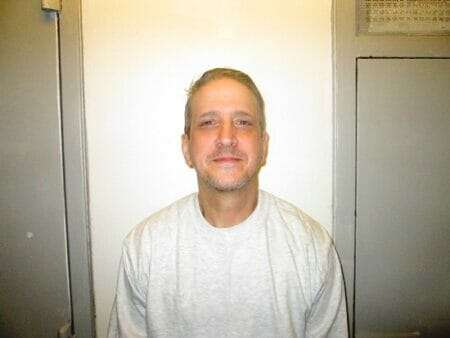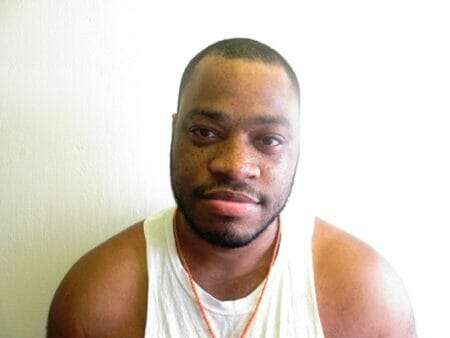
John Grant was sentenced to death by the State of Oklahoma for a prison murder. According to court documents John Grant would murder Gay Carter, who was stabbed 16 times at Dick Connor Correctional Center in Hominy. John Grant would be convicted and sentenced to death.
Oklahoma Death Row Inmate List
John Grant 2021 Information
Gender: Male
Race: Black
Height: 5 ft 11 in
Weight: 157 lbs
Hair Color: Black
Eye Color: Brown
OK DOC#: 102816
Birth Date: 4/12/1961
Current Facility: OKLAHOMA STATE PENITENTIARY, MCALE
Reception Date: 12/30/1980
John Grant More News
On November 13, 1998, Grant savagely and repeatedly stabbed Gay Carter, a food service supervisor at the Connor Correction Center in Hominy, Oklahoma. Grant used a prison-made “shank” similar to a sharpened screwdriver. Grant was serving a total of one-hundred thirty (130) years for four separate armed robberies and had been in prison for about twenty years prior to this offense. On a previous stay at Connor Correctional Center, Grant had worked in the kitchen and he knew Carter; however, Grant lost this job because he was fighting with another inmate.
¶ 3 The morning of and the morning before this murder, Grant and Carter argued over the breakfast tray served to Grant. The previous morning Grant told Carter, “I’ll get you bitch,” and the morning of the murder Grant stated, “Your mine.” Inmates Jerry James and Ronald Kuykendall, who held jobs in the dining area, witnessed these arguments.
¶ 4 After the last argument, James and Kuykendall saw Grant loitering in a storage area where cleaning supplies were kept, adjacent to the main dining area. Carter left the dining area to go to another building where the kitchen was located. When she returned, Grant grabbed her and pulled her into a mop closet. Inside the closet, Grant stabbed Carter numerous times in the chest while holding her mouth closed.
¶ 5 Witnesses summoned Sergeant Daniel Gomez, the first Correctional Officer to arrive. Gomez saw Grant still struggling with Carter. Grant then stood up and faced Gomez, looked at him with a vacant stare, and ran across the dining hall to the storage room, while still carrying the shank in his hand. Grant shut the door, closing himself inside.
¶ 6 After Grant left the mop closet, medical personnel arrived to aid Carter. They found that she was not breathing, and they could not find any vital signs. Carter was transported to the hospital, but efforts to revive her were unsuccessful. Medical Examiner Robert Hemphill determined that Carter died as a result of sixteen stab wounds. Carter’s aorta was punctured, causing rapid blood loss resulting in her death.
¶ 7 The storage room to where Grant fled, has a wire mesh ceiling through which Correctional Officer Tony Reeves observed Grant. Grant ignored orders to lie down on the floor. Grant held the shank to his chest and ran into the wall, apparently in an attempt to stab himself. A special team of correctional officers entered the storage room and Grant made stabbing motions toward the officers. The officers were able to subdue Grant with the use of an electrical shock device.
https://caselaw.findlaw.com/ok-court-of-criminal-appeals/1291074.html
John Grant Execution
Oklahoma executed a man Thursday for the 1998 stabbing death of a prison cafeteria worker, the state’s first lethal injection following a six-year moratorium.
John Marion Grant, 60, who was strapped to a gurney inside the execution chamber, began convulsing and vomiting after the first drug was administered. Several minutes later, two members of the execution team wiped the vomit from his face and neck.
Before the curtain was raised to allow witnesses to see into the execution chamber, Grant could be heard yelling, “Let’s go! Let’s go! Let’s go!” He delivered a stream of profanities before the lethal injection started. He was declared unconscious about 15 minutes after the first of three drugs was administered and declared dead about six minutes after that, at 4:21 p.m.
Grant was the first inmate to be executed since a series of flawed lethal injections in 2014 and 2015. He was serving a 130-year prison sentence for several armed robberies when witnesses say he dragged prison cafeteria worker Gay Carter into a mop closet and stabbed her 16 times with a homemade shank. He was sentenced to die in 1999.
Oklahoma moved forward with the lethal injection after the U.S. Supreme Court, in a 5-3 decision, lifted stays of execution that were put in place on Wednesday for Grant and another death row inmate, Julius Jones, by the 10th U.S. Circuit Court of Appeals.
The state’s Pardon and Parole Board twice denied Grant’s request for clemency, including a 3-2 vote this month to reject a recommendation that his life be spared.
Oklahoma had one of the nation’s busiest death chambers until problems in 2014 and 2015 led to a de facto moratorium. Richard Glossip was just hours away from being executed in September 2015 when prison officials realized they received the wrong lethal drug. It was later learned the same wrong drug had been used to execute an inmate in January 2015.
The drug mix-ups followed a botched execution in April 2014 in which inmate Clayton Lockett struggled on a gurney before dying 43 minutes into his lethal injection – and after the state’s prisons chief ordered executioners to stop.
While the moratorium was in place, Oklahoma moved ahead with plans to use nitrogen gas to execute inmates, but ultimately scrapped that idea and announced last year that it planned to resume executions using the same three-drug lethal injection protocol that was used during the flawed executions. The three drugs are: midazolam, a sedative; vecuronium bromide, a paralytic; and potassium chloride, which stops the heart.
Oklahoma prison officials recently announced that they had confirmed a source to supply all the drugs needed for Grant’s execution plus six more that are scheduled to take place through March.
“Extensive validations and redundancies have been implemented since the last execution in order to ensure that the process works as intended,” the Department of Corrections said in a statement.
More than two dozen Oklahoma death row inmates are part of a federal lawsuit challenging the state’s lethal injection protocols, arguing that the three-drug method risks causing unconstitutional pain and suffering. A trial is set for early next year.








